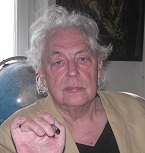Moord op vier vrouwen
 Soms kom je iets tegen, dat door merg en been gaat.
Soms kom je iets tegen, dat door merg en been gaat.
Dat is het geval bij het onderstaande gedicht van de Albanese schrijfster Natasha Lako.
Hier zijn vier vrouwen in koelen bloede doodgeschoten. Heldinnen, die tot de verbeelding spreken.
Waarom?
Wie zijn ze?
Wanneer gebeurde dit en waarom?
Wie stonden hier tegen over elkaar.
Wie -kortom- zijn ‘ze’ en ‘we’.
Ik benaderde tevergeefs diverse mensen, maar kreeg uiteindelijk het antwoord uit Albanië van Artan Metohu, een Albanese kennis van vroeger, die ik vond na bemiddeling van mijn vriend Peter Flik.
Lees eerst het gedicht maar even.
Van Natasha Lako
De vier heldinnen van Mirdita
Marta, Shkurta, Prena en Mrika
het lijkt alsof zij altijd in onze ogen staan.
Voor elk van hen kozen ze een nacht
totdat ze onverwachts er vier doodden.
Vier nachten werden in stukken gehakt.
Er waren vier morgens, zij vieren bleven.
En heel onverwachts, werden zij samen vier dagen
zelfs de kogels, waar ze vielen, doofden het licht.
Zo dicht bij elkaar zijn ze
zoals horizonpunten zijn ze vier richtingen.
En waar we ook gaan, waar we ook zijn
steeds vinden wij ze, de vier horizonpunten.
(Vertaling Ad van Rijsewijk met hulp van een Albanese vriend)
Kacinar in Mirdita

Albanië riep in 1912 de onafhankelijkheid uit.
Dit werd bevestigd in 1913 in het verdrag van Londen.
In 1916 werd het noorden van het land bezet door de dubbelmonarchie Oostenrijk-Hongarije.
Het incident speelde zich in 1917 af in het plaatsje Kacinar in de noordelijke provincie Mirdita.
Enver Hoxha was een gevreesd dictator die lange tijd met ijzeren vuist Albanië regeerde.
Hij liep achter Stalin aan, achter Mao en dreef zijn land in een isolement waar bijvoorbeeld absoluut geen godsdienstvrijheid was.
De verklaring
Dit is wat Artan schrijft:
Hello Ronald
These four women have become a legend in the history of the North Albania province of Miredita. This region is known to be a catholic christian area inhabited 100 % by catholic Christians.
The history of the four women goes back to the year 1917.
As the matter of fact on the 3 November was the anniversary of their death.
They died while fighting against a group of Austrian soldiers who had come to their village called Kacinar.
They came to their house and started to plunder property and goods and all the jewelery. These women were widows as their husbands had died of terminal diseases.
They were at the age between 22 and 27 and had little children from 2 - 6 years old.
They confronted the Austrian soldiers to defende their home and property and shoot dead one of them who was trying to take a way their little calf, who was going to be a cow later, something very important for these women at those days.
The Austrian commander ordered the soldier to shoot these women and even killed their little children.
This act made the whole village of Kacinar to stand up and fight against the Austrian soldiers. Later they were obliged to abandon the village and run away for their life, living many dead soldiers behind.
The heroic performance of these women became a legend in the history of Albania, and a sort of insipiration for freedom and indipendence
I am not sure on the number of children.
Some say there were four children killed, some say there were three children killed.
 About this legend there has been very little or almost nothing spoken during the time of Enver Hoxha.
About this legend there has been very little or almost nothing spoken during the time of Enver Hoxha.
It could be because Hoxha himself was not interested to glorify this tragic event of these four women for a number of reasons:
1 - There was nothing he could connect to his ideology regarding these women as this happened long ago before he came to power, and exactly when he was 5 years old.
2 - Miredita has been a region with 100 % Roman Catholic Christians, strongly disliked and persecuted by an atheist man as Enver Hoxha.
3 - Enver Hoxha was very careful in selecting people who could be proclaimed heros, as he didn't want just anyone to take the glory and become a legend. He was obsesed with glory and personal cult of his own.
I can understand why the Albanians you have asked don't know about it. It was almost not writen or mentioned anywhere, appart from the region of Miredite.
Groetjes Artan
Ik benaderde Artan in 2009. Hij is inmidddels overleden.
Het gedicht is opgenomen in de bundel ‘Ik heb tien benen‘, in 1990 verschenen bij uitgeverij De Geus in Breda. ISBN: 90 5226 010 9

